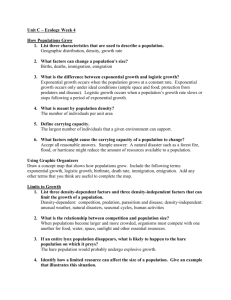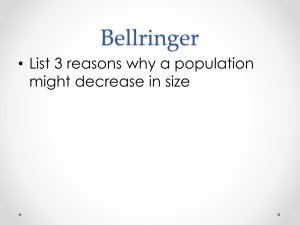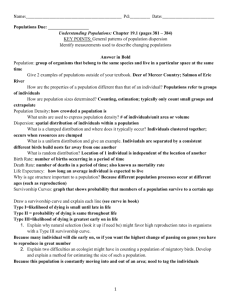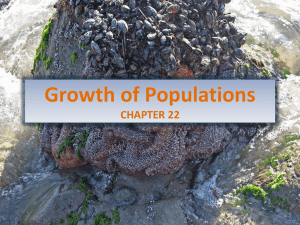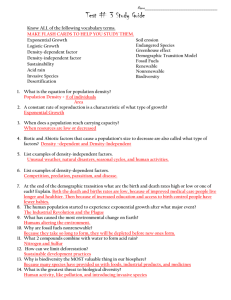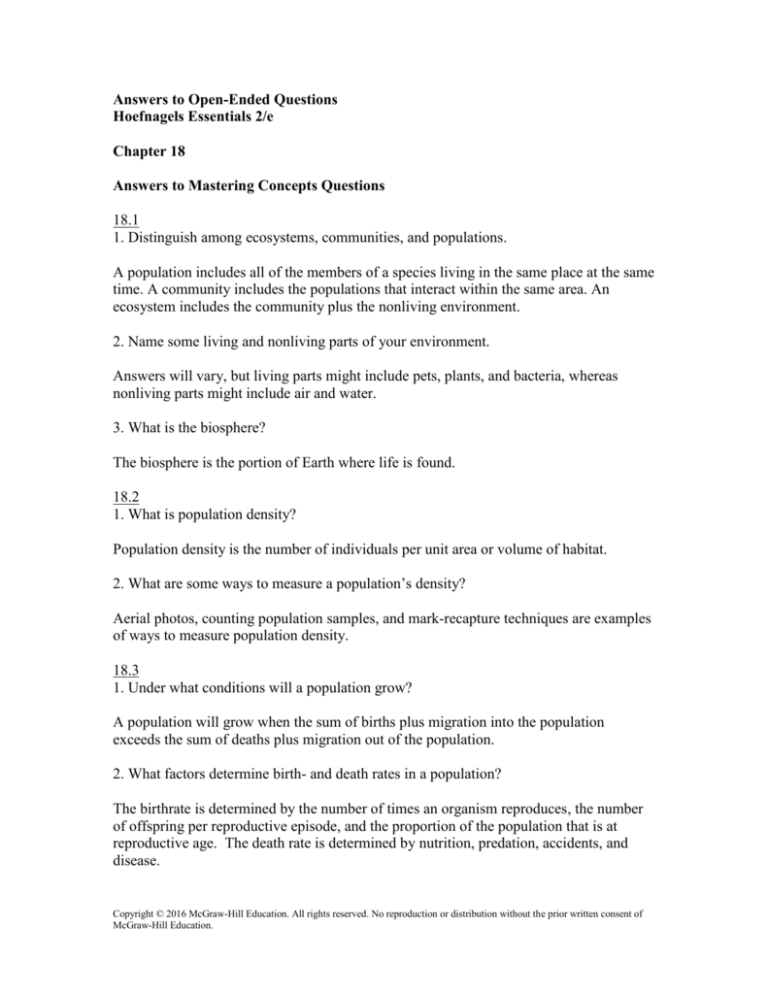
Answers to Open-Ended Questions
Hoefnagels Essentials 2/e
Chapter 18
Answers to Mastering Concepts Questions
18.1
1. Distinguish among ecosystems, communities, and populations.
A population includes all of the members of a species living in the same place at the same
time. A community includes the populations that interact within the same area. An
ecosystem includes the community plus the nonliving environment.
2. Name some living and nonliving parts of your environment.
Answers will vary, but living parts might include pets, plants, and bacteria, whereas
nonliving parts might include air and water.
3. What is the biosphere?
The biosphere is the portion of Earth where life is found.
18.2
1. What is population density?
Population density is the number of individuals per unit area or volume of habitat.
2. What are some ways to measure a population’s density?
Aerial photos, counting population samples, and mark-recapture techniques are examples
of ways to measure population density.
18.3
1. Under what conditions will a population grow?
A population will grow when the sum of births plus migration into the population
exceeds the sum of deaths plus migration out of the population.
2. What factors determine birth- and death rates in a population?
The birthrate is determined by the number of times an organism reproduces, the number
of offspring per reproductive episode, and the proportion of the population that is at
reproductive age. The death rate is determined by nutrition, predation, accidents, and
disease.
Copyright © 2016 McGraw-Hill Education. All rights reserved. No reproduction or distribution without the prior written consent of
McGraw-Hill Education.
3. Describe the three patterns of survivorship curves.
The curves are numbered from the top to the bottom of the graph. In a Type I
survivorship curve, most individuals survive to reproductive age and then die near the
end of the maximum lifespan. In a Type II survivorship curve, the death rate is constant
throughout the lifespan. In a Type III survivorship curve, most deaths occur early in life,
and few individuals survive to old age.
18.4
1. Explain why an organism cannot produce large numbers of offspring that receive
extended parental care.
An organism has limited resources and energy to devote to reproduction. The more
offspring an individual produces, the less parental effort each offspring can receive.
2. Distinguish between opportunistic and equilibrium life histories.
In opportunistic species, individuals tend to be small and short-lived, with high
reproductive rates and little parental care for the young. Equilibrium species are typically
large, long-lived, and slow to reproduce, with extensive care for the young.
18.5
1. What conditions support exponential population growth?
Exponential population growth is supported in environments where resources are
essentially unlimited.
2. How does logistic growth differ from exponential growth?
In exponential growth, the population doubles at regular intervals, and no limiting factors
slow it down. In logistic growth, limiting factors slow population growth and cause it to
eventually level off.
3. Distinguish between density-dependent and density-independent factors that limit
population size, and give three examples of each.
Density-dependent factors limit population size when a population’s density is high.
Three examples are infectious diseases, predation, and competition, all of which are
intensified by crowding. Density-independent factors may limit populations of any size.
Examples are severe weather conditions, floods, and oil spills.
18.6
1. What factors affect human birth- and death rates?
Copyright © 2016 McGraw-Hill Education. All rights reserved. No reproduction or distribution without the prior written consent of
McGraw-Hill Education.
Factors that affect human birthrates include the population’s age structure, government
policies that punish or reward having children, the availability of family planning
programs, and the education level of women. Factors that affect death rates include
access to food, health care, and clean water.
2. What are some of the environmental consequences of human population growth?
Some environmental consequences of human population growth include increased
demands for resources such as energy, food, and clean water. Fossil fuel use releases
gases that contribute to global climate change. Increasing demand for food means greater
expansion of settlements and farms into wild lands, causing further loss of biodiversity.
Water supplies are also under increasing pressure as the population grows.
Write It Out
1. List some of the ways you have interacted with your surroundings today. Categorize
each item on your list as a population-, community-, or ecosystem-level interaction.
Answers will vary, but population-level interactions should be with other people,
community-level interactions should be with other species, and ecosystem-level
interactions should be with the nonliving world.
2. Why might an ecologist be interested in studying population dynamics?
Understanding how and why populations grow or shrink is relevant to disease prevention,
land management, the protection of endangered species, and many other fields.
3. Refer to the rotifer population in figure 18.7. After 21 days, will the population be
greater than, less than, or equal to 6300 individuals? Explain your answer.
The population will be greater than 6300 individuals. On day 20, the population grew by
966 individuals and ended at 5356. Since the population is growing exponentially, the
number of individuals added on day 21 will be greater than the number added on day 20.
Even if the number of individuals added on day 21 were equal to the number added on
day 20, the population would exceed 6300 individuals by the end of day 21.
4. Domesticated animals, such as house cats, may disturb ecosystems. Are outdoor cats a
density-independent or density-dependent factor limiting the populations of birds?
Explain your answer. Then, brainstorm as many ways as you can think of for how home
bird feeders might raise or lower bird population sizes.
Outdoor cats hunt birds. Because cats are likely to kill more birds when bird populations
are dense, cats are a density-dependent factor limiting bird populations. Home bird
feeders provide resources for birds, so they may help to increase bird population sizes.
On the other hand, feeders concentrate bird populations in a small area, increasing the
Copyright © 2016 McGraw-Hill Education. All rights reserved. No reproduction or distribution without the prior written consent of
McGraw-Hill Education.
chance that a predator (such as a house cat) can make a catch. The crowded conditions
also allow diseases to spread more easily.
5. White nose syndrome is a disease in bats caused by an infectious fungus (see figure
15.37). The mortality rate of bats that contract the infection is nearly 90%. Is white nose
syndrome a density-dependent or a density-independent factor limiting the size of bat
populations? As white nose syndrome becomes more common, how does the carrying
capacity for bats change?
White nose syndrome is a density-dependent factor limiting the size of bat populations.
As bat populations become denser, the disease spreads more easily. As white nose
syndrome becomes more common, the habitat’s carrying capacity for bats will decrease,
because bats may only be able to survive in less-dense colonies.
6. What would the graph in figure 18.16 look like for a declining population? How would
the birthrate compare to the death rate? How would the age structure diagram look?
The line depicting the population size would slope downwards from left to right, and the
birthrate would be less than the death rate. The age structure would show relatively few
individuals in the prereproductive and reproductive age classes.
7. A species with an opportunistic life history occupies a habitat where conditions
fluctuate in two-year cycles; that is, years with optimal conditions for population growth
alternate with suboptimal years. Graph the population size of the species over 6 years,
then indicate on the same graph how the population of a species with an equilibrium life
history would change over the same period.
A species with an opportunistic life history produces many offspring, but with low
survivorship. When conditions are optimal, the population will likely rise quickly,
because more of the offspring will survive to maturity. But when conditions are
suboptimal, the population’s size drops sharply because the offspring receive little
parental care. The spikes and troughs will look similar to the collared lemming
population in figure 18.10. In contrast, the population size of a species with an
equilibrium life history will be relatively stable, even as conditions fluctuate yearly. The
low reproductive rate coupled with extensive parental care means that offspring born in
suboptimal years still have a chance to survive.
8. Overall, humans are using many resources at a faster rate than they can be replenished.
What actions would be necessary to reduce humanity’s ecological footprint to a
sustainable level?
To reduce the ecological footprint, the human population’s growth rate must be
significantly slowed, which will mean reducing birthrates around the world.
Furthermore, the use of nonrenewable resources like fossil fuels must be greatly reduced.
Copyright © 2016 McGraw-Hill Education. All rights reserved. No reproduction or distribution without the prior written consent of
McGraw-Hill Education.
Pull it Together
1. Add growth rate to the concept map. Explain how a population’s growth rate changes
throughout exponential and logistic growth.
“Growth rate” connects with “may be high when the population has a high rate of” to
“Births.” “Growth rate” connects with “may be low when the population has a high rate
of” to “Deaths.” Growth rate increases as a population grows exponentially. In logistic
growth, growth rate is low when the population is small, increases when the population is
of moderate size, and then decreases again as the population approaches the carrying
capacity.
2. Add the following terms to this concept map: density-dependent, density-independent,
carrying capacity, and age structure.
Both “Density-dependent” and “Density-independent” connect with the phrase “factors
cause” to “Deaths.” “Logistic growth” connects with the phrase “levels out at the” to
“Carrying capacity.” “Age structure” connects with the phrase “influences the rate of” to
“Births.”
3. Describe the trends for human birth- and death rates in more- and less-developed
countries.
In more-developed countries the birthrate is typically about equal to the death rate, and
population growth is zero (in the absence of immigration). In less-developed countries,
the birthrate is often much higher than the death rate, so the populations are growing.
Copyright © 2016 McGraw-Hill Education. All rights reserved. No reproduction or distribution without the prior written consent of
McGraw-Hill Education.


